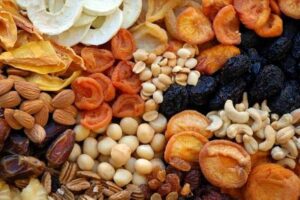What Is 5 A Day? Eating The Appropriate Diet

What are carbohydrates? Why are they necessary for health?
Simply put, carbohydrates are nothing but the sugar, fiber, and starch found in vegetables, fruits, grains, and other dairy products. Today, some have tarnished their reputation – but they are an important part of a healthy human diet.
Carbohydrates are one of the macronutrients; This means that they are one of the three main ways to provide energy to the body (the other two macronutrients are proteins and fats).
And remember, carbohydrates are essential for health. They provide fuel and energy needed by the central nervous system and body muscles. Most importantly, they prevent protein from being consumed as a source of body energy. This work also activates the metabolism (fuel) of fats.
There are many different issues and unknowns on the subject of carbohydrates; Good carbs and bad carbs. Simple carbohydrates and complex carbohydrates. A little later in this article, we will discuss all of these. But first, let us tell you the foods rich in carbohydrates and the benefits of each one.
What are foods rich in carbohydrates?
The foods you normally eat are full of this important nutrient (which, unfortunately, is not consumed properly). Some of the richest sources of carbohydrates are:
- Brown rice
- Consumption size – 185 grams
- Available carbohydrates – 143 grams
- Nutritional value percentage – 48%
Brown rice is a rich source of plant lignans that can protect your heart from disease. Brown rice is also very rich in magnesium. This mineral also supports heart health, just like selenium, another mineral abundant in brown rice. In addition, brown rice can lower cholesterol and lower the risk of diabetes.
How to include brown rice in your diet
Just like the methods of using white rice; You can even replace white rice with brown rice, as it’s a healthier option (and, of course, you won’t be compromising your carb intake either).
- Buckwheat or buckwheat
- Consumption size – 170 grams
- Available carbohydrates – 122 grams
- Nutritional value percentage – 41%
Buckwheat, in addition to carbohydrates, is rich in protein. This food contains 12 amino acids that support energy supply, proper growth, and muscle production in the body. And also, the fiber in buckwheat helps digestion and improves the health of the digestive system by preventing many digestive problems.
How to include buckwheat in the diet
You can use buckwheat flour to make pancakes.
- Red beans
- Consumption size – 184 grams
- Available carbohydrates – 113 grams
- Nutritional value percentage – 38%
Red beans can reduce the risk of heart disease. One of the ways that red beans can reduce the risk of heart disease is that they lower bad cholesterol levels without affecting good cholesterol. Red beans also contain compounds called alpha-amylase inhibitors, which prevent the absorption and breakdown of starch, which causes weight gain.
How to include red beans in the diet
You can simply use red beans in vegetable salad; Or add it to your breakfast omelet.
- lentils
- Consumption size – 192 grams
- Available carbohydrates – 115 grams
- Nutritional value percentage – 38%
Lentils are a rich source of protein, and if you’re the type of vegetarian who needs more protein, you can reap the benefits of lentils. Lentils also contain fiber, folic acid, and potassium—nutrients essential for heart health. A good source of non-heme iron, lentils help fight fatigue. This food item is also considered a very good substitute for meat.
How to include lentils in the diet
Adding lentils to soups containing meat can be a good start to include them in your diet. You can also add lentils to salads containing dark vegetables.
- Quinoa
- Consumption size – 170 grams
- Available carbohydrates – 109 grams
- Nutritional value percentage – 36%
As a whole grain, quinoa is rich in protein, iron, and fiber. Protein helps repair cells and generate new cells. Quinoa can be a great option for diabetics. And the antioxidants in quinoa help prevent cell damage and slow down the aging process.
How to include quinoa in the diet
Combining quinoa with your favorite smoothie can quickly increase its protein content.
- Oat
- Consumption size – 156 grams
- Available carbohydrates – 103 grams
- Nutritional value percentage – 34%
In addition to carbohydrates, oats are rich in antioxidants – the most important of which is avenanthramide. Oats increase the production of nitric oxide, thereby lowering blood pressure. Oats are also rich in beta-glucan, a type of soluble fiber. Beta glucan reduces cholesterol and also helps in weight loss.
How to include oats in the diet
The easiest way to add oats to your diet is to eat them at breakfast. You can also add fruit and other nuts to oatmeal for a nutritious breakfast.